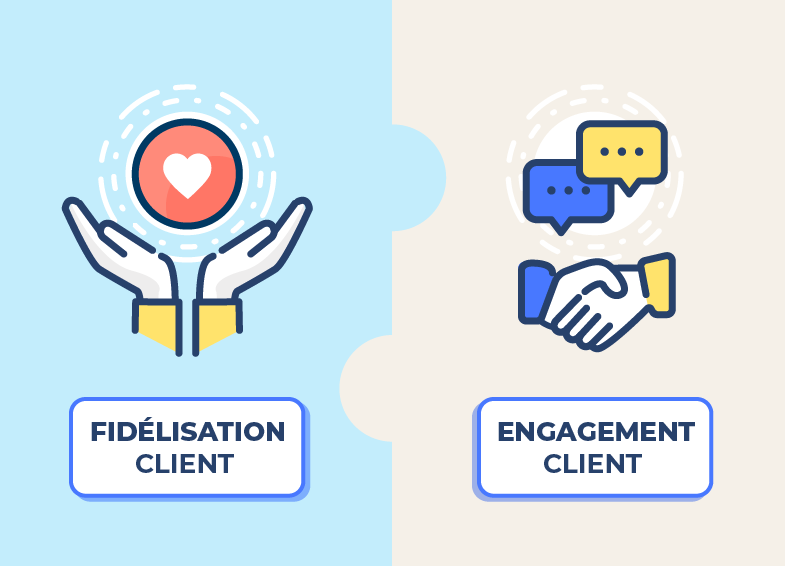Customer loyalty and customer engagement, how to make the difference?


Category: Loyalty
In customer marketing strategies, the terms "loyalty" and "engagement" are essential but often used interchangeably. However, they have distinct meanings and specific objectives. Understanding the difference between these two concepts is crucial to developing an effective CRM strategy to maximize customer satisfaction and loyalty. Let's decipher the difference.
While both concepts are important in CRM strategies, understanding the differences between them is essential to creating effective programs tailored to each objective.
The loyalty is generally defined as the ability to retain existing customers by encouraging them to make repeat purchases. This is often achieved through rewards programs, exclusive offers and benefits reserved for loyal customers.
A loyal customer is a customer who is satisfied with their purchase and experience. Customer loyalty is the common ideal of all brands.
In practice, customer loyalty strategies allow companies to satisfy their customers in a personalized way. However, loyalty does not guarantee recommendation or exclusivity to a brand. Indeed, in the context of loyalty, the customer will not necessarily recommend a brand to others and may stop buying its products if a more advantageous offer is proposed by a competitor.
The goal of loyalty is to strengthen the relationship between the brand and the customer and to ensure that the customer comes back to buy again.
Engagement, on the other hand, is more focused on creating an emotional and trusting relationship between the company and the customer. Engaged customers are true ambassadorsfor their favorite brands. As benevolent customers, they make sure to recommend the products and services they appreciate to their friends and family. They can be found on the social networks of their favorite brands interacting with other followers. They leave likes, comments and of course their opinions on the published content. They are also ready to advise other users on the brand's products and services.
Customer engagement strategies can therefore include initiatives such as creating an online community, organizing customerevents, participating in charitable causes and communicating with customers on a regular basis. This emotional relationship can lead to long-term loyalty to the company.
The goal of engagement is to create long-term brand loyalty, even if more attractive offers are available. Engagement is based on an emotional connection with the customer.
It is important to note that retention and engagement are not mutually exclusive. In fact, loyalty loyalty programs can be used to strengthen customer engagement by offering exclusive benefits and special offers that create an emotional connection with the company. Similarly, engagement initiatives can help build loyalty by creating a more personal relationship and building customer trust in the company.
Customer engagement allows to multiply the benefits of customer loyalty. Thanks to ambassadors, brands enrich their community. It's an asset that promotes the conversion of prospects who will be more inclined to engage as well.
In addition, a brand's followers enable reluctant prospects to move forward in the buying cycle. Through reviews, discussion forums and social networks, they are willing to educate"newbies" on the benefits of products and services.
In terms of profitability, customer engagement costs 5 to 10 times less than customer retention. In other words, customer loyalty strategies are effective but require a marketing budget. With customer engagement, it is the customers themselves who promote the brand for free.
Finally, engagement and loyalty programs offer another important advantage: they allow toenrich customer knowledge. This allows the company to feed its CRM and further adapt loyalty and engagement programs. Interactions with loyal and engaged customers provide valuable information about their preferences, needs and buying behavior.
Brands must therefore strike a balance between loyalty and engagement to create an effective customer marketing strategy.
For optimize customer loyalty and customer engagement and impact business performance, it is essential to implement effective strategies. Here are a few tips on how to do this:
In an increasingly competitive environment, brands must use all possible strategies to remain competitive and differentiated. In addition, customer recommendation and word of mouth have proven to be very effective. However, to make this possible, it is imperative for brands to find ways toencourage loyal customers to make a long-term commitment. While customer loyalty is a goal that can be achieved at the point of purchase, customer engagement requires more effort. By combining these complementary approaches, companies can create a solid base of loyal and engaged customers that will contribute to their growth and profitability.
Contents